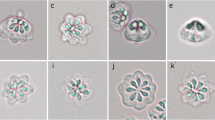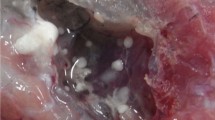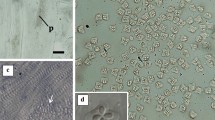Abstract
Three species of the Kudoid parasite (Myxozoa: Multivalvulida) were observed in the somatic muscle of Japanese parrotfish Calotomus japonicus caught off the coast of western Japan. All three species formed pseudocysts in myofibers and caused subclinical infections. The three Kudoa species were distinguished by spore morphology, as well as their 18S and 28S rDNA sequences. We identified a previously undescribed taxa Kudoa igami n. sp. with spores that were stellate with rounded peripheral edges and five to six polar capsules (prevalence 29.3 %). Kudoa igami n. sp. were morphologically most similar to Kudoa neothunni but were distinguishable by a more rounded shape in the apical view. Molecular analyses demonstrated that the K. igami n. sp. is closely related to Kudoa thalassomi; however, the similarity in the 28S rDNA sequence was <96 % and the spore morphology was different. We found Kudoa thalassomi in one sample (prevalence 2.4 %), which is a new host and geographical record for this species. Kudoa lateolabracis, which causes postmortem myoliquefaction in Chinese sea bass Lateolabrax sp. and olive flounder Paralichthys olivaceus was found in Japanese parrotfish (prevalence 41.5 %) for the first time, but did not cause myoliquefaction. We also expanded the host record for the brain-infecting Kudoa yasunagai (prevalence 94.1 %). In addition, an unidentified microsporidia was observed in the somatic muscle (prevalence 23.3 %).






Similar content being viewed by others
References
Adlard RD, Bryant MS, Whipps CM, Kent ML (2005) Multivalvulid myxozoans from eastern Australia: three new species of Kudoa from scombrid and labrid fishes of the Great Barrier Reef, Queensland, Australia. J Parasitol 91(5):1138–1142
Arai Y, Matsumoto K (1953) On a new sporozoa, Hexacapsula neothunni gen. et sp. nov., from the muscle of yellowfin tuna, Neothunnus macropterus. Bull Jap Soc Sci Fish 18:293–299
Burger MAA, Adlard RD (2010) Phenotypic variation in a significant spore character in Kudoa (Myxosporea: Multivalvulida) species infecting brain tissue. Parasitology 137(12):1759–1772
Burger MAA, Adlard RD (2011) Low host specificity in the Kudoidae (Myxosporea: Multivalvulida) including seventeen new host records for Kudoa thalassomi. Folia Parasitol 58(1):1–16
Fiala I (2006) The phylogeny of Myxosporea (Myxozoa) based on small subunit ribosomal RNA gene analysis. Int J Parasitol 36(14):1521–1534
Heiniger H, Adlard RD (2012) Host specificity and local infection dynamics of Kudoa leptacanthae n. sp (Multivalvulida: Kudoidae) from the pericardial cavity of two Zoramia spp. (Perciformes: Apogonidae) at Lizard Island lagoon, Queensland, Australia. Parasitol Int 61(4):697–706
Heiniger H, Cribb TH, Adlard RD (2013) Intra-specific variation of Kudoa spp. (Myxosporea: Multivalvulida) from apogonid fishes (Perciformes), including the description of two new species, K. cheilodipteri n. sp and K. cookii n. sp., from Australian waters. Syst Parasitol 84(3):193–215
Hillis DM, Dixon MT (1991) Ribosomal DNA: molecular evolution and phylogenetic inference. Q Rev Biol 66(4):411–453
Huelsenbeck JP, Ronquist F (2001) MRBAYES: Bayesian inference of phylogenetic trees. Bioinformatics 17(8):754–755
Iwashita Y et al (2013) Food poisoning associated with Kudoa septempunctata. J Emerg Med 44(5):943–945
Katoh K, Standley DM (2013) MAFFT multiple sequence alignment software version 7: improvements in performance and usability. Mol Biol Evol 30(4):772–780
Kawai T et al (2012) Identification of Kudoa septempunctata as the causative agent of novel food poisoning outbreaks in Japan by consumption of Paralichthys olivaceus in raw fish. Clin Infect Dis 54(8):1046–1052
Kent ML et al (2001) Recent advances in our knowledge of the Myxozoa. J Eukaryot Microbiol 48(4):395–413
Li YC, Sato H, Tanaka S, Ohnishi T, Kamata Y, Sugita-Konishi Y (2013) Characterization of the ribosomal RNA gene of Kudoa neothunni (Myxosporea: Multivalvulida) in tunas (Thunnus spp.) and Kudoa scomberi n. sp in a chub mackerel (Scomber japonicus). Parasitol Res 112(5):1991–2003
Lom J, Dyková I (2006) Myxozoan genera: definition and notes on taxonomy, life-cycle terminology and pathogenic species. Folia Parasitol 53(1):1–36
Martinez de Velasco G, Rodero M, Cuellar C, Chivato T, Mateos JM, Laguna R (2008) Skin prick test of Kudoa sp. antigens in patients with gastrointestinal and/or allergic symptoms related to fish ingestion. Parasitol Res 103(3):713–715
Matsukane Y, Sato H, Tanaka S, Kamata Y, Sugita-Konishi Y (2010) Kudoa septempunctata n. sp (Myxosporea: Multivalvulida) from an aquacultured olive flounder (Paralichthys olivaceus) imported from Korea. Parasitol Res 107(4):865–872
Matsukane Y, Sato H, Tanaka S, Kamata Y, Sugita-Konishi Y (2011) Kudoa iwatai and two novel Kudoa spp., K. trachuri n. sp. and K. thunni n. sp. (Myxosporea: Multivalvulida), from daily consumed marine fish in western Japan. Parasitol Res 108(4):913–926
Miller TL, Adlard RD (2013) Unicapsula species (Myxosporea: Trilosporidae) of Australian marine fishes, including the description of Unicapsula andersenae n. sp. in five teleost families off Queensland, Australia. Parasitol Res 112(8):2945–2957
Moran JDW, Whitaker DJ, Kent ML (1999) A review of the myxosporean genus Kudoa Meglitsch, 1947, and its impact on the international aquaculture industry and commercial fisheries. Aquaculture 172(1–2):163–196
Nylander JAA (2004) MrModeltest v2. Program distributed by the author. Uppsala University, Evolutionary Biology Centre
Patashnik M, Groninger HS Jr, Barnett H, Kudo G, Koury B (1982) Pacific Whiting, Merluccius productus. Abnormal muscle texture caused by myxosporidian-induced proteolysis. Mar Fish Rev 44:1–12
Ronquist F, Huelsenbeck JP (2003) MrBayes 3: Bayesian phylogenetic inference under mixed models. Bioinformatics 19(12):1572–1574
Sato H (2011) Biology of the myxozoa, a newly recognized parasitic pathogen causing food poisoning. Yamaguchi. J Vet Med 38:1–26
Stamatakis A, Hoover P, Rougemont J (2008) A rapid bootstrap algorithm for the RAxML web servers. Syst Biol 57(5):758–771
Stehr C, Whitaker DJ (1969) Host–parasite interaction of the myxosporean Kudoa paniformis (Kabata & Whitaker 1981) and Kudoa thyrsites (Gilchrist 1924) in the muscle of the Pacific whiting, Merluccius productus (Ayres): an ultrastructural study. J Fish Dis 9:505–517
Swofford DL (2002) PAUP*: phylogenetic analysis using parsimony, version 4.0b10. Sinauer Associates, Massachusetts
Whipps CM, Kent ML (2006) Phylogeography of the cosmopolitan marine parasite Kudoa thyrsites (Myxozoa: Myxosporea). J Eukaryot Microbiol 53(5):364–373
Whipps CM, Adlard RD, Bryant MS, Kent ML (2003a) Two unusual myxozoans, Kudoa quadricornis n. sp (Multivalvulida) from the muscle of goldspotted trevally (Carangoides fulvoguttatus) and Kudoa permulticapsula n. sp (Multivalvulida) from the muscle of Spanish mackerel (Scomberomorus commerson) from the Great Barrier Reef, Australia. J Parasitol 89(1):168–173
Whipps CM, Adlard RD, Bryant MS, Lester RJ, Findlay V, Kent ML (2003b) First report of three Kudoa species from eastern Australia: Kudoa thyrsites from mahi mahi (Coryphaena hippurus), Kudoa amamiensis and Kudoa minithyrsites n. sp. from sweeper (Pempheris ypsilychnus). J Eukaryot Microbiol 50(3):215–219
Whipps CM et al (2004) Phylogeny of the multivalvulidae (Myxozoa : Myxosporea) based on comparative ribosomal DNA sequence analysis. J Parasitol 90(3):618–622
Yokoyama H (2003) A review: gaps in our knowledge on myxozoan parasites of fishes. Fish Pathol 38(4):125–136
Yokoyama H, Itoh N (2005) Two multivalvulid myxozoans causing postmortem myoliquefaction: Kudoa megacapsula n. sp from red barracuda (Sphyraena pinguis) and Kudoa thyrsites from splendid alfonso (Beryx splendens). J Parasitol 91(5):1132–1137
Yokoyama H, Whipps CM, Kent ML, Mizuno K, Kawakami H (2004) Kudoa thyrsites from Japanese flounder and Kudoa lateolabracis n. sp from chinese sea bass: causative myxozoans of post-mortem myoliquefaction. Fish Pathol 39(2):79–85
Yokoyama H, Yanagida T, Takemaru I (2006) The first record of Kudoa megacapsula (Myxozoa : Multivalvulida) from farmed yellowtail Seriola quinqueradiata originating from wild seedlings in South Korea. Fish Pathol 41(4):159–163
Yokoyama H, Yanagida T, Shirakashi S (2012) Kudoa ogawai n. sp (Myxozoa: Multivalvulida) from the trunk muscle of Pacific barrelfish Hyperoglyphe japonica (Teleostei: Centrolophidae) in Japan. Parasitol Res 110(6):2247–2254
Yokoyama H, Suzuki J, Shirakashi S (2014) Kudoa hexapunctata n. sp. (Myxozoa: Multivalvulida) from the somatic muscle of Pacific bluefin tuna Thunnus orientalis and re-description of K. neothunni in yellowfin tuna T. albacares. Parasitol Int 63:571–579
Acknowledgments
We would like to thank the Wakayama Prefectural Fisheries Experimental Station staff for storing the fish and helping with sampling. This research was supported in part by the SATREPS program of the Japan Science and Technology Agency (JST) to SS.
Author information
Authors and Affiliations
Corresponding author
Rights and permissions
About this article
Cite this article
Shirakashi, S., Yamane, K., Ishitani, H. et al. First report of Kudoa species in the somatic muscle of the Japanese parrotfish Calotomus japonicus (Scaridae) and a description of Kudoa igami
, n. sp. (Myxozoa: Multivalvulida).
Parasitol Res 113, 2515–2524 (2014). https://doi.org/10.1007/s00436-014-3901-1
Received:
Accepted:
Published:
Issue Date:
DOI: https://doi.org/10.1007/s00436-014-3901-1




